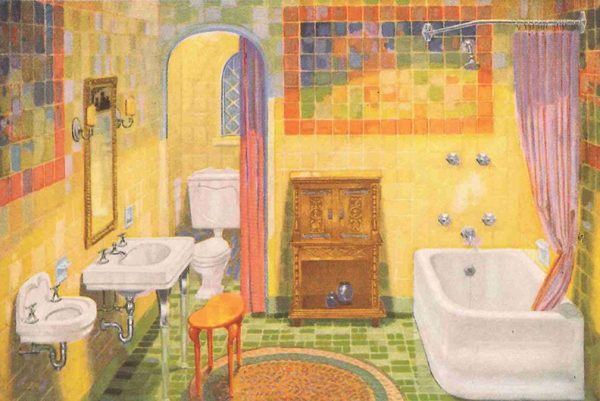
A bathroom in a 1928 American Standard catalog is radiant with brightly colored tile. (Photo: Arcalus Archive)
Original bathroom tile should be a delight to the old-house enthusiast. But some become insecure in the face of nonstop advice doled out by real-estate agents, renovation contractors, and even preservation societies—that bathrooms are fair game for updating, no matter what the time period of the house.
This is rash for bathrooms built during the 20th century, many of which are functional and quirkily attractive to this day. And as any devotee of old houses knows, tiles matched to the era of the house will never go out of style, unlike modern “updates” that are in fashion today but will appear dated 10 years from now.
Consider original tile to be part of the bones of the house, and learn to appreciate what you’ve got. My two 1940s bathrooms, which can only be described as “early gas station,” have white 4×4 square ceramic tile around each of their tubs—how boring can you get? But I’ve learned to love the simplicity of my white tiles, Art Deco tubs, and leaky snub-nosed sink. For 10 years, everyone has told me to rip out all of the tile and put in something gorgeous, spa-like, contemporary, and sleek. And for 10 years I’ve resisted, trying to better understand and appreciate my original bathrooms. Isn’t that what old-house ownership is about?
1900-1920: Classic White Tile
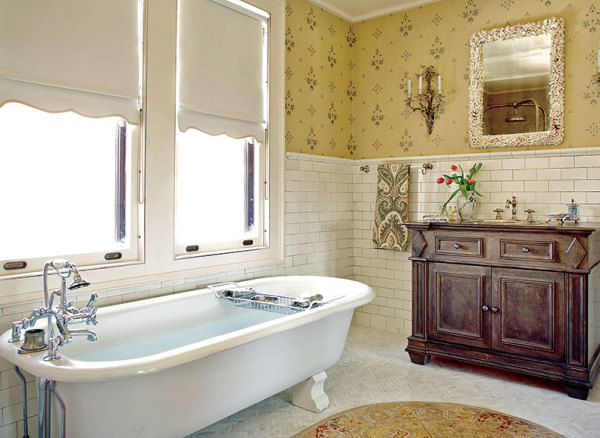
The master bath in A 1912 house designed by Addison Mizner sports a classic white subway tile wainscot.
Christian Giannelli
The good news for anyone living in any style of home built in the early 20th century is that the current popularity of subway tiles, specifically white ones, fits your home. The turn-of-the-century fad for all-white bathrooms was borne out of the Victorian notion that dirt harbored germs. White tiles made the dirt easier to see, and thus eradicate.
White 3×6 subway tiles matched with a white pedestal or wall-mounted sink are period appropriate to any home built between 1900 and 1930 (6×6 tiles were sometimes used as well). If your original tiles have long gone missing and you can’t pin down what first appeared on your walls, you can almost never go wrong with a plain white bathroom. The clean lines and excellent materials from this first part of the 20th century are a classic design statement that still resonates today.
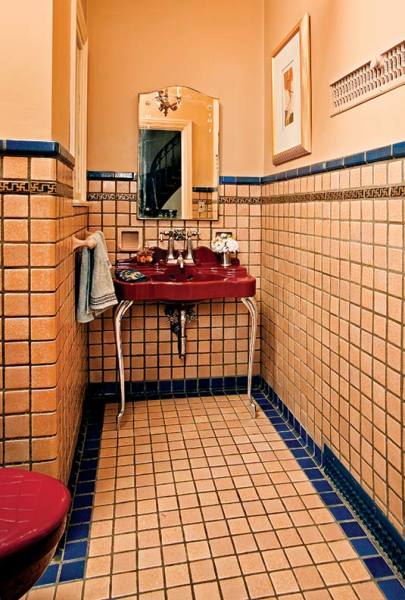
A powder room in a 1930 Mediterranean Revival house makes a colorful tile statement.
Joseph Hilliard
1920s & 1930s: Colored and Textured Tile
These decades brought color to bathrooms, with pastel subway tile making its debut in the late 1920s and bolder Art Deco-inspired colors arriving in the ’30s. Many current owners will delight in having something interesting to preserve, while others find the color trends of past periods challenging as they contend with pink-, burgundy-, and lavender-tiled bathrooms.
In Bungalow Bathrooms, author Jane Powell points out that the use of art tiles in bathrooms was actually not found during the golden age of the Arts & Crafts movement (1900-1920), but became part of 1930s bath design. These tiles could be handmade, or just made to look so, and were often square, slightly irregular, and set with a wider grout line.
A Tudor home of the 1930s might have a bathroom with tiles depicting Viking ships or goldfish, or a stunning Spanish-style frieze. If your home is graced with these tiles, by all means work to save them, restore them, and honor them.
An array of 3-D tiles made their debut during this time, too, and could feature wave patterns, rolls, or ridges, adding interest to finished walls. During the Great Depression, subway tiling continued and often was paired with bold Art Deco-inspired geometric decorations like pencil borders, hexagonal accent tiles, or caps in a contrasting color.
Read more:
- 1920s-40s Baths
- Tile Repair & Removal Tips
- The Evolution of Colored Bathroom Fixtures
- The History of the Lavatory
Tile of the 1940s: Modernism, Economy, and New Materials
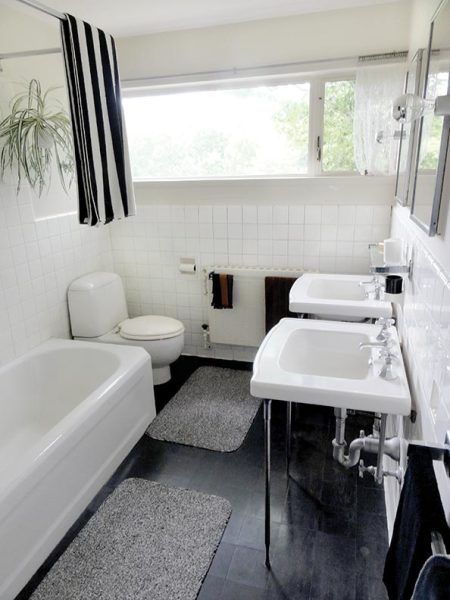
The bathroom in architect Walter Gropius’ 1938 house is a model of Modernist thinking.
Todd Larson
The confluence of new materials and manufacturing methods during World War II, the huge postwar building boom, and the spread of Modernism and its edict that homes be “machines for living” led to the plain vanilla 1940s bathroom. Subway tile went out of style, and the ubiquitous 4×4 tile gained prominence.
While colored tiles didn’t disappear, the fallout from the Great Depression and then the war made luxury colors less affordable and available (and combinations that did get used were more somber, like burgundy and dark gray). Meanwhile, Modernism pushed back toward the earlier idea of hygienic white and pared-down efficiency.
In the hefty 1941 tome Furniture and Decoration, Period and Modern, the lone paragraph devoted to bathrooms states, “The kitchen and the bathroom should really be regarded as factories. They are purely utilitarian. A few years ago we were all over-enthusiastic on the subject of color…bathrooms now are a nice, clear, clean white tile.”
Cheaper, faster ways to build bathrooms also were introduced, and tile board became a DIY favorite. Most of these faux-tile boards, backed with Masonite or, later, MDF, failed from moisture over time.
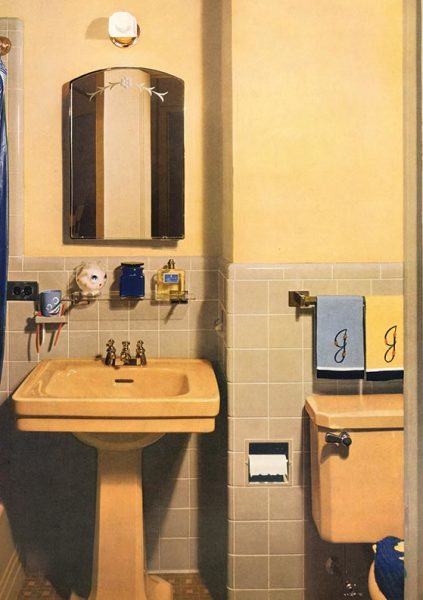
A mid-century Sherwin-Williams Style Guide heralded the comeback of colored tile.
Arcalus Archive
1950s: The Return of Colored Tile
The 1950s brought a renewed sense of fun and optimism. People weren’t keeping their kitchens and bathrooms as hygienic “factories.” Enter the era of pink, mint, and baby blue tiles—think 1950s automobiles. It’s estimated that 5 million pink bathrooms remain in use in American mid-century homes. Mosaic tiling, with small rectangular patterns and 1″ squares, became popular in the 1950s. Later that decade, tile more liberally encased tubs and even went floor to ceiling throughout the bath. (Prior to the 1950s, tile was usually applied as a wainscot around the walls of the bathroom, reaching higher only around the tub.)
1960s: Luxury Tile
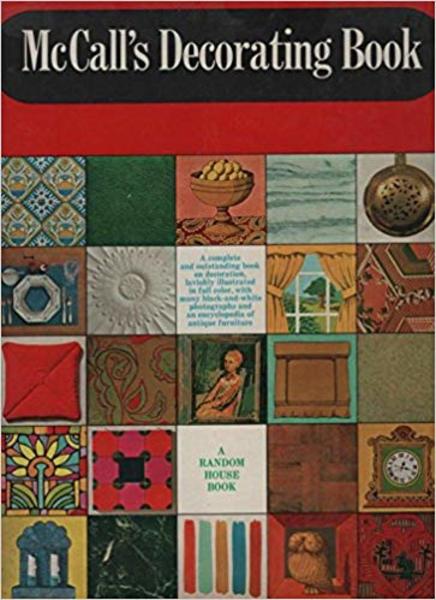
McCall’s Decorating Book, 1964, describes the new era of the “decorated bathroom.”
McCall’s Decorating Book from 1964 introduces the chapter “Luxurious Bathrooms” by describing two oversized bathrooms (one 16′ x 25′ with a window wall and a crystal chandelier), saying, “These exceptional and handsome bathrooms typify the new excitement that now surrounds this erstwhile neglected room.”
Tile mosaics continued throughout the 1960s, but other materials stole the show in this new era of the “decorated bathroom.” From the 1960s on, tile would be only part of the overall effect as furniture, wallpaper, sconces, steam showers, carpeting, and mirror walls overran the bathroom.
We remain in this fanciful bathroom phase today with the inclusion of ever more expensive materials like marble and stone. In reaction, I’ve embraced anew my little “factory” bathrooms with their boring off-the-shelf tile. Understanding their place in history has brought me acceptance. I hope you feel the same for your jade-green bathroom.







